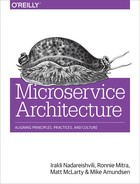Part III. Microservices in Practice
The Microservices Way at Hootsuite
Vancouver-based Hootsuite is a pioneer in social media for business. The company was formed by members of Invoke Media who built a platform to manage their own social network interactions and then realized that other companies had the same need. As the company grew, so did their monolithic, PHP-based platform. In order to meet the demands of their market through a 100+ team of developers, they are evolving their application to a collection of product-oriented microservices.
Hootsuite took a design-based approach to their microservice migration from the outset. They recognized that defining the right logic boundaries can be a harder problem than introducing new technology. They use what they call “distributed domain-driven design” as a means of breaking services out of their monolith. API definitions and associated contracts provide a means of describing service scope and function, and API consumers are involved in the creation of both. The Hootsuite team found that API design guidelines helped to create a common language for this process. Over time, Hootsuite has classified their microservices into three categories: data services that encapsulate key business entities and ensure scalability, functional services that combine data services with business logic to execute core business logic, and facade services that decouple consumer contracts from core functional logic. Hootsuite’s design approach continues to evolve as their microservice implementation matures.
Hootsuite’s organization includes product-aligned teams made up of five to seven people. They also have a cross-functional platform team that is responsible for frameworks and tooling, and has visibility across the organization. To address common interest areas like APIs and JavaScript, they have a collection of “guilds” that anyone can join. In the spirit of empowerment and delivery speed, Hootsuite does not have any governance checkpoints that intrude on a team’s development process. Instead, they have a set of community-defined principles and tools that guide microservice development. Recently, they formed a technology architecture group made up of senior technical leaders to address technological issues that have a broad effect on the organization, but this group was formed organically—not as the result of an executive edict. Beier Cai, Director of Software Development, likens Hootsuite’s governance approach to “eventual consistency.” This empowered, iterative style is a match for the microservices way.
Fittingly given the company’s origin, Hootsuite has created a goal-oriented toolset for microservices. To address deployment, they use Docker and Mesos. For service discovery, they use Consul and NGINX. These four open source components are used together in a solution called “Skyline” that enables secure, dynamic, performant routing in their growing fabric of microservices. They have also found Scala, Akka, and the Play framework useful in building their individual services, and leverage both HTTP and Kafka for interservice communication. The tooling extends to the design process as well. To make sure developers know what services and components are available for use in service development, the Hootsuite team created a tool to dynamically generate system visualizations that link to code repositories and operational documentation. As needs arise, more tools are discovered or created.
Hootsuite’s evolution to a microservice architecture continues. They have over a dozen microservices in production with many more on the way. As a result of embracing an approach to microservices adoption that cuts across their architecture, organization, culture, processes, and tools, they have been able to improve their delivery speed, flexibility, autonomy, and developer morale.
